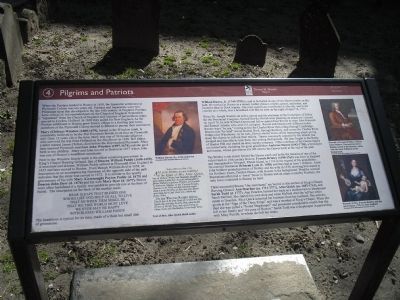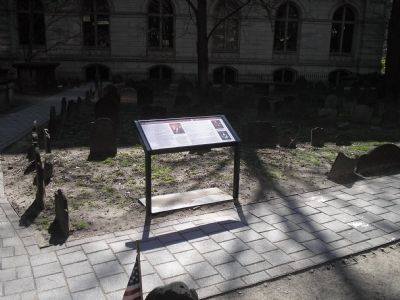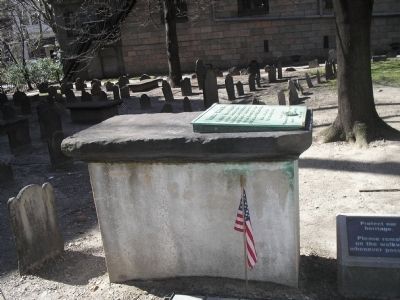Downtown in Boston in Suffolk County, Massachusetts — The American Northeast (New England)
Pilgrims and Patriots
Mary (Chilton) Winslow (1608-1679), buried in the Winslow tomb, is commonly believed to be the first European female to set foot on Plymouth soil. Only 12 years old at the time, Mary was one of 30 female pilgrims who survived the trip from Holland on the Mayflower in 1620. Her father, a tailor named James Chilton, died before the ship reached Plymouth. Mary later married Plymouth merchant John Winslow (1597-1674) and she gave birth to ten children. Mary and John moved to Boston in 1657 where John was one of Boston’s wealthiest merchants.
Next to the Winslow family tomb is the oldest remaining gravestone in King’s Chapel Burying Ground, that of Deacon William Paddy (1600-1658). A merchant and skinner, William Paddy arrived in Plymouth from England in 1635 and later moved to Boston. Even though William died in 1658, an inscription on an accompanying footstone on the opposite side of the path indicates that the stone was carved in 1672. It is similar to the nearby gravestones of his wife Mary (Greenough) Payton Paddy (d. 1675) and Deacon John Dyer (d. 1676) and his wife Mary Dyer (d. 1677). Stones were often backdated if a family was unable to provide one at the time of burial. The inscription on the back of the marker reads:
whose life God help us all to live
that so when tiem shall be
that we this world must leve
we ever may be happy
with blessed William Paddy
The headstone is typical for its time, made of a thick but small slab of greenstone.
William Dawes, Jr. (1745-1799) is said to be buried in one of two Dawes tombs on this path. He worked in Boston as a tanner, leather dresser, retailer, grocer, and trader, and owned a shop in Dock Square. His most significant contribution to the city, and to the country as a whole, was a horseback ride that he took on the night of April 18, 1775.
When Dr. Joseph Warren, an active patriot and the chairman of the Committee of Safety for the Provincial Congress, learned that the British were planning an attack on Concord on April 19, he sent William Dawes and fellow patriot Paul Revere to warn John Hancock and Samuel Adams, who were in Lexington. Revere and Dawes took different routes. Revere went “by sea,” rowing across the Charles River then riding through Cambridge. Dawes rode “by land” across Boston Neck, through Roxbury, and across the Charles River bridge near Watertown. As he rode, Dawes alerted towns of the impending attack giving them the chance to call out their militia. Dawes was nearly captured by the British, but escaped and was able to trick them into ending their pursuit. He later fought in the Battle of Bunker Hill and started an army supply company. Other members of the Dawes family are buried here, including his great grandfather Ambrose Dawes (1642-1705), a bricklayer and mason, whose gravestone sits left next to the Dawes tomb at the end of the path.
The Brinley tomb stands behind the Dawes tomb and holds the remains of one of the richest men in 18th century Boston. Francis Brinley (1690-1765) was born in England and immigrated to Newport, Rhode Island, in 1710 at the request of his grandfather. He married Bostonian Deborah Lyde (b. 1698) and they had at least 7 children. Artist John Smibert painted portraits of Brinley and his wife in 1729, showing him seated at his Roxbury estate, Datchet House, with Boston in the background. Wealthy colonial Bostonians often had a “town” house in Boston and an estate in nearby Roxbury, the only town connected to Boston by land.
Three successful Boston “she-merchants” are buried in this section of King’s Chapel Burying Ground: Ann Dearden (ca. 1711-1771), Alice Quick (ca. 1687-1761), and Sarah Todd (d. 1777). Ann Dearden learned her trade as a maidservant to shopkeeper Sarah McNeal. She started her own shop and when McNeal died she left her entire estate to Dearden. Alice Quick inherited her business from her husband. She sold dry goods at the “Sign of the Three Kings” and was member of King’s Chapel. When she died she was called a “Noted Shopkeeper” and possessed considerable wealth that she left to her family and “the poor of Boston.” Sarah Todd was a shopkeeper in partnership with Mary Purcell, to whom she left her estate.
Topics. This historical marker is listed in these topic lists: Cemeteries & Burial Sites • Colonial Era • Settlements & Settlers. A significant historical date for this entry is April 18, 1775.
Location. 42° 21.497′ N, 71° 3.594′ W. Marker is in Boston, Massachusetts, in Suffolk County. It is in Downtown. Marker can be reached from Tremont Street, on the right when traveling north. Marker is located along the walking trail in King’s Chapel Burying Ground. Touch for map. Marker is in this post office area: Boston MA 02108, United States of America. Touch for directions.
Other nearby markers. At least 8 other markers are within walking distance of this marker. William Dawes Jr. (here, next to this marker); Welcome to King’s Chapel Burying Ground (a few steps from this marker); The First Governor (a few steps from this marker); King’s Chapel Burial Ground (a few steps from this marker); The Ice King, the Castle Captain, and the She-Merchant (a few steps from this marker); Life and Death in Colonial Boston (a few steps from this marker); Robert Keayne / Col. Nicholas Paige (within shouting distance of this marker); The Chevalier de Saint Sauveur (within shouting distance of this marker). Touch for a list and map of all markers in Boston.
More about this marker. The right of the marker contains a “Portrait of Francis Brinley, 1729, by John Smibert. This portrait shows Brinley seated at his Roxbury estate with the town of Boston in the background.” Below this is a “Portrait of Mrs. Francis Brinley and her son Francis, 1729, by John Smibert.” Both of these paintings are courtesy of the Metropolitan Museum of Art. The center of the marker features a painting of William Dawes, Jr. by an unknown artist, courtesy of the Evanston Historical Society. Below this is the Text of Mrs. Alice Quick death notice. It reads: “Boston, February 20th, 1762. All such persons as are indebted to the estate of Mrs. Alice Quick, late of Boston, widow and shopkeeper, deceased, are again desired to settle their accounts and pay their respective balances to Joshua Winslow and Ezekiel Goldthwait, Esquires, or Mr. Thomas Knight, executors to her will; and those who shall neglect doing it by the first day of June next, may depend upon being sued to July Court next, without any further notice.
The said Thomas Knight informs, that he lives in the same house in Cornhill that Mrs. Quick did, and keeps the same shop, where he sells all sorts of the best teas, and a great variety of china, goods and merchandise, on the lowest terms.”
Related markers. Click here for a list of markers that are related to this marker. Take a tour of the markers found in King’s Chapel Burying Ground.
Also see . . . King's Chapel and Burying Ground. Details of the Freedom Trail from the City of Boston website. (Submitted on May 15, 2009, by Bill Coughlin of Woodland Park, New Jersey.)
Credits. This page was last revised on January 30, 2023. It was originally submitted on May 15, 2009, by Bill Coughlin of Woodland Park, New Jersey. This page has been viewed 2,110 times since then and 33 times this year. Photos: 1, 2, 3. submitted on May 15, 2009, by Bill Coughlin of Woodland Park, New Jersey.


